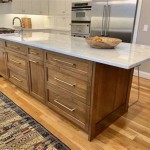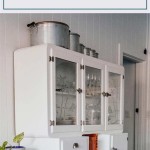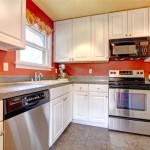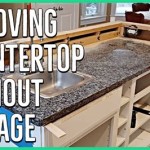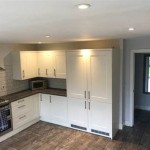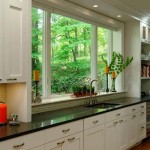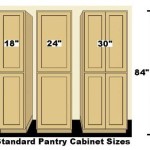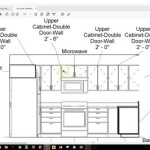What Type of Kitchen Cabinets Are Popular Now?
Kitchen cabinets form the cornerstone of kitchen design, influencing both the aesthetic appeal and the functionality of the space. As design trends evolve, so too do the preferred styles, materials, and configurations of kitchen cabinetry. Understanding current popular choices is crucial for homeowners undertaking renovations, builders designing new homes, and interior designers seeking to create modern and appealing kitchens. Recent trends highlight a shift towards minimalist aesthetics, sustainable materials, and personalized storage solutions. This article provides an overview of popular kitchen cabinet types, focusing on the styles, materials, and features that are currently in high demand.
Shaker Style Cabinets: Timeless Simplicity
Shaker style cabinets continue to maintain their position as a consistently popular choice in kitchen design. Characterized by their clean lines, simple frame-and-panel construction, and understated elegance, Shaker cabinets offer versatility that allows them to seamlessly integrate into a wide range of kitchen styles, from traditional to contemporary. The door typically features a five-piece construction with a flat center panel and a simple, square-edged frame. This minimalist design makes Shaker cabinets adaptable to various colors and finishes, further contributing to their enduring appeal.
The popularity of Shaker cabinets stems from their ability to create a timeless and uncluttered aesthetic. Unlike more ornate or decorative cabinet styles, Shaker cabinets avoid excessive detailing, allowing the focus to remain on the overall kitchen design and other key elements, such as countertops, backsplashes, and appliances. This simplicity also makes them relatively easy to clean and maintain, a practical consideration for busy homeowners. Furthermore, the flat panel design lends itself well to different hardware options, providing opportunities for personalization.
The color palette for Shaker cabinets is diverse, reflecting current design trends. While white remains a classic and perennially popular choice, offering a bright and airy feel, other popular colors include gray, navy blue, and various shades of green. These colors can be used to create different moods and styles, from a serene and sophisticated ambiance to a bolder and more contemporary statement. Natural wood finishes, such as oak and maple, are also gaining popularity, offering warmth and texture to the kitchen space.
Flat-Panel (Slab) Cabinets: Modern Minimalism
Flat-panel cabinets, also known as slab cabinets, represent a hallmark of modern and contemporary kitchen design. These cabinets feature a simple, door without any frame or detailing, creating a sleek and streamlined appearance. The minimalist aesthetic of flat-panel cabinets is particularly well-suited for those seeking a clean, uncluttered, and minimalist kitchen design. The smooth, unbroken surfaces of these cabinets contribute to a sense of spaciousness and openness, making them a popular choice for smaller kitchens or those aiming for a modern, urban feel.
The material options for flat-panel cabinets are diverse, ranging from wood veneers and laminates to acrylic and metal. Each material offers a unique aesthetic and performance characteristics. Wood veneers, such as walnut or cherry, provide a natural and warm look, adding depth and character to the kitchen. Laminates, on the other hand, are a more cost-effective option that offers a wide range of colors and textures. Acrylic cabinets are known for their high-gloss finish and durability, making them a popular choice for contemporary kitchens. Metal cabinets, typically stainless steel, offer a sleek and industrial look, often used in modern or commercial-style kitchens.
The hardware choices for flat-panel cabinets are typically minimalist as well. Many homeowners opt for handleless designs, using push-to-open mechanisms or integrated pulls for a seamless look. When hardware is used, it is often sleek and understated, complementing the clean lines of the cabinets. The color palette for flat-panel cabinets is often neutral, with white, gray, and black being popular choices. However, bold colors can also be used to create a striking accent wall or focal point in the kitchen.
Open Shelving and Glass-Front Cabinets: Display and Accessibility
While traditional closed cabinets remain a staple in most kitchens, open shelving and glass-front cabinets are gaining popularity as complementary design elements. These features offer opportunities to display decorative items, showcase favorite dishware, and add visual interest to the kitchen space. Open shelving involves removing cabinet doors altogether, leaving the shelves exposed. This creates a more open and airy feel, allowing for easy access to frequently used items. Glass-front cabinets, on the other hand, feature glass panels in the doors, allowing a glimpse of the contents inside. This can be used to showcase particularly attractive items or to add a touch of elegance to the kitchen.
Open shelving is often incorporated as an accent feature, rather than replacing all upper cabinets. It is particularly well-suited for displaying cookbooks, plants, and decorative objects. However, it requires careful styling and organization to avoid a cluttered and messy appearance. Items displayed on open shelves should be cohesive and visually appealing, and the shelves should be regularly dusted to maintain a clean look. The materials used for open shelving can vary, but wood, metal, and glass are common choices.
Glass-front cabinets can be used to display more formal or delicate items, such as china, glassware, or silver. The glass panels can be clear, frosted, or textured, depending on the desired level of privacy and the overall aesthetic. Clear glass allows for maximum visibility, while frosted or textured glass can obscure the contents to some extent. Glass-front cabinets are often used in conjunction with interior lighting to highlight the displayed items and create a warm and inviting ambiance. The frame of the glass-front cabinets can match the rest of the cabinetry or be a contrasting color or material to add visual interest.
Customization and Personalized Features: Tailoring to Needs
Beyond specific styles, a key trend in kitchen cabinet design is the increasing demand for customization and personalized features. Homeowners are seeking cabinets that are not only aesthetically pleasing but also tailored to their individual needs and lifestyles. This includes incorporating specialized storage solutions, optimizing cabinet layouts for functionality, and selecting materials and finishes that reflect personal preferences. Customization allows homeowners to create a kitchen that is both beautiful and highly efficient, maximizing storage space and streamlining workflow.
Specialized storage solutions are becoming increasingly popular, addressing specific needs such as pantry organization, spice storage, and waste management. Pull-out shelves, drawer dividers, and vertical storage compartments can help to maximize space and keep items organized. Integrated waste and recycling bins can be concealed within cabinets, keeping them out of sight and maintaining a clean and tidy kitchen. Corner cabinets, often a source of wasted space, can be optimized with lazy Susans or pull-out shelving systems. Appliance garages can be used to conceal small appliances, such as toasters and blenders, keeping the countertops clutter-free.
Optimizing cabinet layouts involves considering the flow of the kitchen and the placement of appliances and work zones. The work triangle, which connects the sink, refrigerator, and stove, is a fundamental principle of kitchen design, but it can be adapted to suit individual needs and preferences. Islands and peninsulas can be used to create additional countertop space and storage, as well as to define different zones within the kitchen. The height of cabinets and countertops can also be customized to accommodate different users, ensuring ergonomic comfort and accessibility. Upper cabinets can be extended to the ceiling to maximize storage space and create a more streamlined look.
Sustainable Materials and Practices: Eco-Conscious Choices
As environmental awareness grows, sustainable materials and practices are becoming increasingly important in kitchen cabinet design. Homeowners are seeking cabinets that are not only beautiful and functional but also environmentally responsible. This includes selecting materials from sustainable sources, using low-VOC finishes, and choosing manufacturers that prioritize eco-friendly practices. Sustainable kitchen cabinets can help to reduce the environmental impact of the kitchen renovation process and create a healthier living environment.
Materials from sustainable sources include reclaimed wood, bamboo, and formaldehyde-free plywood. Reclaimed wood is salvaged from old buildings or structures, giving it a unique character and reducing the demand for new timber. Bamboo is a rapidly renewable resource that is strong and durable, making it a popular choice for cabinet construction. Formaldehyde-free plywood is made without the use of formaldehyde, a known carcinogen, reducing the risk of indoor air pollution. These materials contribute to a more sustainable kitchen design, reducing the environmental impact of the construction process.
Low-VOC (volatile organic compound) finishes are another important aspect of sustainable kitchen cabinet design. VOCs are chemicals that are released into the air from paints, stains, and adhesives, contributing to indoor air pollution. Low-VOC finishes contain fewer of these chemicals, reducing the risk of health problems and creating a healthier living environment. Water-based finishes are a popular alternative to traditional solvent-based finishes, offering comparable performance with lower VOC emissions. Choosing low-VOC finishes is a simple way to make a significant impact on indoor air quality.
Manufacturers that prioritize eco-friendly practices are also becoming increasingly popular. These companies use sustainable manufacturing processes, such as reducing waste, recycling materials, and conserving energy. They may also have certifications from organizations such as the Forest Stewardship Council (FSC), which ensures that the wood used in their products comes from responsibly managed forests. Supporting these manufacturers helps to promote sustainable practices throughout the industry and reduce the environmental impact of kitchen cabinet production.
Color Trends: Embracing Neutrals and Pops of Color
Color plays a crucial role in setting the tone and style of a kitchen, and current trends reflect a balance between timeless neutrals and carefully chosen pops of color. While white cabinets remain a consistently popular choice for their ability to create a bright and airy feel, other neutral tones such as gray, beige, and greige (a blend of gray and beige) are also in high demand. These neutral colors provide a versatile backdrop for incorporating pops of color through accent walls, backsplashes, and accessories. The choice of cabinet color significantly impacts the overall aesthetic and ambiance of the kitchen space.
White cabinets are favored for their clean, classic, and timeless appeal. They can brighten up a dark kitchen, create a sense of spaciousness, and complement a wide range of design styles. White cabinets also provide a neutral canvas for showcasing other design elements, such as countertops, backsplashes, and hardware. Different shades of white can be used to create different effects, from a crisp and modern look to a warmer and more traditional feel. Off-white or cream cabinets can add a touch of warmth and sophistication, while bright white cabinets can create a sleek and contemporary look.
Gray cabinets have gained significant popularity in recent years, offering a sophisticated and versatile alternative to white. Gray can be used to create a calming and serene atmosphere, or it can be paired with bolder colors for a more dramatic effect. Different shades of gray can evoke different moods, from a light and airy feel to a deep and moody ambiance. Warm grays with beige undertones can add warmth and coziness, while cool grays with blue undertones can create a more modern and sleek look. Gray cabinets are particularly well-suited for contemporary and transitional kitchen designs.
Pops of color can be incorporated into the kitchen through accent cabinets, islands, or hardware. Blue, green, and yellow are popular choices for adding a touch of personality and vibrancy to the space. Navy blue cabinets can create a sophisticated and elegant look, while sage green cabinets can evoke a sense of nature and tranquility. Sunny yellow cabinets can brighten up a dark kitchen and create a cheerful and inviting atmosphere. The choice of accent color should complement the overall color scheme and reflect the homeowner's personal style. Carefully chosen pops of color can transform a neutral kitchen into a visually appealing and personalized space.

5 Kitchen Cabinet Trends Popular With Homeowners Now

Kitchen Cabinet Styles Explained The 4 Most Popular Types

7 Best Kitchen Cabinet Materials To Protect You From Poor Quality Horrors

Kitchen Cabinet Trends For 2024 According To Designers

15 Kitchen Cabinet Ideas And Trends For 2024

10 Types Of Kitchen Cabinets To Consider During A Remodel

Latest Trends In Kitchen Cabinets And How To Get Them

Popular Cabinet Door Styles Trends In 2024 Model Remodel

10 Types Of Kitchen Cabinets To Consider During A Remodel

8 Types Of Kitchen Cabinets Must Know Guide
Related Posts

